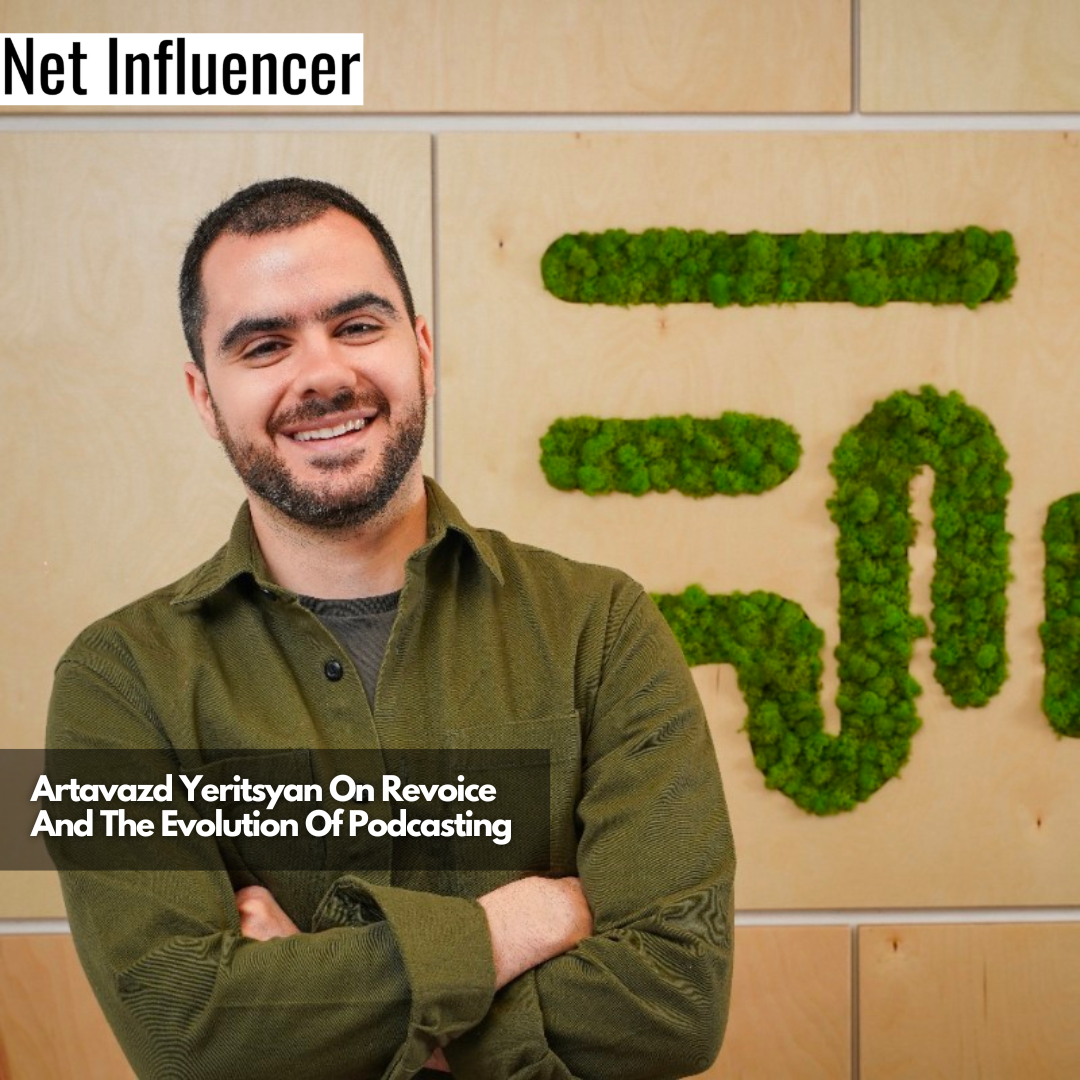Technology
Artavazd Yeritsyan On Revoice And The Evolution Of Podcasting
Artavazd Yeritsyan created Podcastle, a platform that enables podcasters to make content from scratch. Today, Artavazd shares more details about Podcastle’s newest feature, Revoice, and how it helps podcasters.
Artavazd Yeritsyan created Podcastle, a platform that enables podcasters to make content from scratch. Today, Artavazd shares more details about Podcastle’s newest feature, Revoice, and how it helps podcasters.
Who Is Artavazd Yeritsyan?
Artavazd Yeritsyan is the CEO and founder of Podcastle Inc. The platform aims to become a one-stop shop for broadcast storytelling, meaning they’re not just giving pieces of the puzzle, like editing or creating tools; they want to cover the entire workflow from A to Z.
Podcastle allows users to create, record, and edit podcasts — the entire production. It also helps in the distribution and marketing of podcasts. Artavazd Yeritsyan On Revoice And The Evolution Of Podcasting
Artavazd says, “We want to be the platform where we can help, especially novice & independent podcasters who are just getting started. Instead of researching, buying, and learning about six or seven tools to create your successful podcast, we’re building a platform where you can do all those things with the support of AI technologies.”

What is Revoice and How Does it Work?
Revoice is your own voice powered by AI, it’s generative AI for voice. With Revoice, podcasters can create digital copies or clones of their own voice and generate audio by typing.
Generated AI is getting a lot of attention today for its capabilities, like texts to photos and Chat GPT. But in the world of audio, it’s quite new and still developing.
What Makes Revoice Different from Other Text-to-Speech Tools?
Revoice is still in its infancy, but it’s getting better and better. Artavazd shares, “We just released an early version of the product after our AI engineers have worked on the technology for the past two years. Our goal as a company is to help simplify the creation process.”
Revoice enables podcasters and creators to generate short- or long-form audio without saying a word. The technologies that exist in the market today don’t usually help in creating very long content. With Revoice, users get the most natural and high-quality version of their voices.
How Did the Idea of Revoice Come About?
“We had the idea for a while, long before all this hype around generative AI. We had this idea about three years ago, and we started working on it about two years ago,” Artavazd shares.
The whole idea behind Revoice is to speed up every podcaster’s production process and make it seamless.
Revoice has become part of a software platform where anyone can create and optimize their workflows to create a podcast. It became an essential tool for many uses like creating an intro, outro, or ad reads for podcasts. These are things podcasters often dislike recording repeatedly as their voices can change.
Artavazd Yeritsyan says, “You can’t keep it [your voice] constant. The more you record, the more variations and inconsistencies arise in the inflections of your voice. It’s hard to read long texts or record long audio without your voice experiencing fatigue. Your voice and emotions become inconsistent over time.”
Industries or Users Benefitting from Revoice
Although Revoice is still at the very early stage of its journey, it has already gained positive reviews from its users. Two of the most common cases users rely on Revoice are doing voiceovers or instances when solo voice is required to overlay a visual presentation, like social media, promo webinars, or training videos.
People also use Revoice to automate existing work, such as turning podcasts into sponsor outreach or simple editing tasks. For example, you already have the podcasts, and you want to edit as you’ve missed a couple of sentences that you want to mention or said the words wrong.
Revoice makes it fast and easy to edit audio files. Artavazd Yeritsyan explains, “You can type the texts and seamlessly incorporate them into your audio file.”
How Revoice Ensures the Safety and Security of its Users
Revoice understands the threats that hackers, deep fakes, and social engineering posts to society, which is why they’ve built strict security measures and safeguards around the misuse of such technology.
“To create your Digital Voice on Podcastle, a user must submit a live recording of 70 distinct, pre-determined sentences– meaning the user cannot simply submit a pre-recorded clip of their own (or someone else’s) voice. These 70 recordings are then manually checked by our team to issue the accuracy of the single voice. And then the recordings are processed through our AI model,” Artavazd explains.
Revoice also requires users to submit a statement through voice recording, testifying that they are giving the platform consent to create their digital voice. The statement also includes users consenting that their digital voices will not be used for illegal purposes.
Support Revoice Offers to New Users
Revoice itself helps users understand AI. It offers plenty of notes, guides, and tips during the onboarding process, as well as videos and tutorials on how the technology can be used.
Success Stories
Revoice is new in the industry, but it has already contributed to the success of many podcasters. Artavazd shares with us one of Revoice’s success stories.
“There is a sales podcast where three folks are speaking. Two of them are generated using Revoice technology while the third uses Podcastle’s own “stock” voices through AI-powered text-to-speech. The podcast sounds natural, like three people having casual conversations on the business of sales. And it’s all generated using Podcastle’s toolkit,” Artavazd says.
There are also many YouTube channels and social media accounts using Revoice as a voiceover tool. These platforms have videos and use Revoice to put educational content on videos.
How Revoice Addresses Issues on Intellectual Property and Monetizing Content
To help address common issues faced by creators today, Revoice guarantees that users retain ownership of their voice or podcasts even when they’re uploaded to the platform. This is different as most platforms will assume ownership of someone else’s content once they’re uploaded to that platform.
In Revoice, all content created by the creator, their voice, and their AI-generated voice are safe and secured. In short, nobody can take anyone’s voice or clone other people’s voices without the owner’s permission.
Platforms or Tools That Will Become Increasingly Important for Creators in the Future
“I can speak about podcasting since we have insight into this market and we’re working closely with this market. One of the essential tools for podcasters will be YouTube. It will be essential to create video content because, in reality, YouTube is the largest platform in terms of podcast listeners, even though they only recently announced a formal YouTube podcasting section and categorization. The fact is, podcasts have thrived on YouTube for many years.,” Artavazd shares.
Artavazd Yeritsyan also thinks that using videos to engage with the audience will start to make more sense in the future. This is also their motivation for deciding which features to add to Revoice. He states, “That’s why we added support for video editing and video recording technologies. So, our podcasters can go hand in hand with the new technologies and offerings YouTube is giving.”

How the Creator Economy Will Evolve in the Future, and What Role Does Revoice Have in This Evolution
For a while, there was a notion that people’s attention spans were decreasing, and they’re now choosing short-form content. But observations for the last couple of years proved otherwise.
People are more engaged with long-form storytelling content better than with short-form content. This means that it’s better for creators to offer podcasts, vlogs, and other long-form content to get an engaged audience. In short-form content, you can get or reach a bigger audience but not with high engagement.
In the future, Artavazd sees a generation where all brands, companies, and creators will start doing a podcast. Podcasting has become mainstream, and people’s perception of it has changed. This is something that Artavazd saw firsthand when he was speaking at conferences.
“When I was speaking at various conferences two years ago, I was asking, ‘How many of you have considered starting a podcast?’ and there were a couple of hands. And when I asked, ‘How many of you actually started doing podcasts?’ only one participant raised their hand. But now, almost 90% of the audience raise their hands when asked if they’ve already started a podcast,” Artavazd states.
How Revoice and AI Technology Shape the Future of Audio Creation and Content Creation
Artavazd Yeritsyan is confident that generative AI will be part of audio and content creation processes in the future. Today, AI expedites the content creation process as it automates almost all parts of the process, whether it’s content for SEO, marketing, or others.
In the future, podcasting will become the next-generation marketing tool businesses will use to get new users and engage with audiences. At some point, users will want to automate those processes, as well, like how AI impacts texts today.
Artavazd says, “So these tools [AI] will automate a lot of processes. Still, of course, podcasts are not about marketing the business or showing off your product. They’re more about having an honest conversation, creating connection with an audience, and these kinds of things. I don’t see that AI is going to replace that.”
People still want to understand what the human on the other side of the microphone thinks and how they speak. In short, people still crave human engagement. And these are things that AI can’t replace.
But in the future, AI will definitely help scale and automate many parts of the creative process and the production workforce.
What’s in Store for Revoice
Revoice will offer configurations to its users. Artavazd explains, “Once they get the digital copy of their voice and if they don’t like how it sounds, we will give configurations so they can change their vocal inflections, add specific emotions, etc.”
Artavazd Yeritsyan recognizes that many users don’t feel good about their voice and would want to make it better. They probably want to make it sound more engaging or casual. Revoice puts in place several features in the future to help users with this dilemma.





















